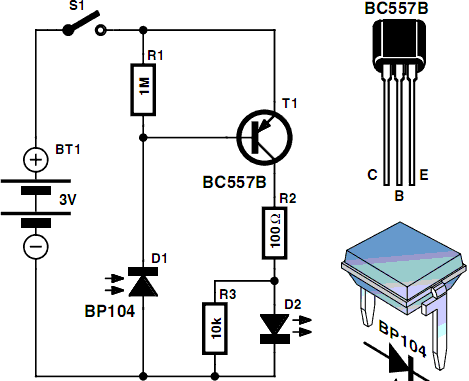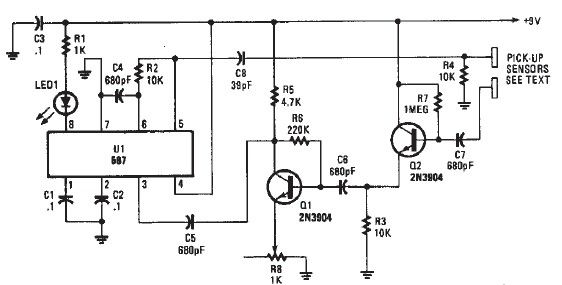
sound detector switch

When the 555 IC goes into timing mode (triggered by an output signal from the sound detector amplifier), the timer's output (pin 3) is set to HIGH for a duration set by C2 and R2. Adjusting R1 will adjust how long it listens, from 10 seconds all the way down to 2/10ths of a second. This could be used to listen for hand claps. All resistors are 5 or 10 percent tolerance, 1/4-watt. All capacitors are 10 percent tolerance, rated 35 volts or higher.
The described circuit utilizes a 555 timer IC configured in monostable mode. In this configuration, the timer is triggered by an external signal from a sound detector amplifier, which detects specific sound patterns, such as hand claps. When the sound detector outputs a signal, it triggers the 555 timer, causing the output at pin 3 to go HIGH.
The duration for which the output remains HIGH is determined by the resistor R2 and capacitor C2. The time period (T) for the monostable operation can be calculated using the formula:
T = 1.1 × R2 × C2
Where T is in seconds, R2 is in ohms, and C2 is in farads. The circuit allows for fine-tuning of the timing duration by adjusting R1, which is connected in series or parallel to R2, depending on the desired adjustment mechanism. This flexibility enables the circuit to listen for hand claps over a range from 10 seconds down to 0.2 seconds, making it versatile for various applications.
The components specified in the circuit design adhere to standard tolerances. All resistors are rated at either 5% or 10% tolerance, ensuring reliable performance within acceptable limits, and are rated for 1/4 watt to handle the power dissipation safely. The capacitors utilized in the circuit are 10% tolerance and rated for 35 volts or higher, providing adequate voltage headroom for the operation of the 555 timer and ensuring stability during the timing cycle.
This circuit can be implemented on a breadboard for prototyping or designed into a PCB for more permanent applications, allowing for integration into systems that require sound detection and response functionalities. Proper attention to component ratings and tolerances will ensure the longevity and reliability of the circuit in practical applications.When the 555 ic goes into timing mode (triggered by an output signal from the sound detector amplifier,) the timer`s output (pin 3) is set into HIGH for a duration set by C2, and R2. adjusting R1 will adjust how long it listens, from 10 seconds all the way down to 2/10ths of a second.
this could be used to listen for hand claps. all resistors are 5 or 10 percent tolerance, 1/4-watt all capacitors are 10 percent tolerance, rated 35 volts or higher 🔗 External reference
The described circuit utilizes a 555 timer IC configured in monostable mode. In this configuration, the timer is triggered by an external signal from a sound detector amplifier, which detects specific sound patterns, such as hand claps. When the sound detector outputs a signal, it triggers the 555 timer, causing the output at pin 3 to go HIGH.
The duration for which the output remains HIGH is determined by the resistor R2 and capacitor C2. The time period (T) for the monostable operation can be calculated using the formula:
T = 1.1 × R2 × C2
Where T is in seconds, R2 is in ohms, and C2 is in farads. The circuit allows for fine-tuning of the timing duration by adjusting R1, which is connected in series or parallel to R2, depending on the desired adjustment mechanism. This flexibility enables the circuit to listen for hand claps over a range from 10 seconds down to 0.2 seconds, making it versatile for various applications.
The components specified in the circuit design adhere to standard tolerances. All resistors are rated at either 5% or 10% tolerance, ensuring reliable performance within acceptable limits, and are rated for 1/4 watt to handle the power dissipation safely. The capacitors utilized in the circuit are 10% tolerance and rated for 35 volts or higher, providing adequate voltage headroom for the operation of the 555 timer and ensuring stability during the timing cycle.
This circuit can be implemented on a breadboard for prototyping or designed into a PCB for more permanent applications, allowing for integration into systems that require sound detection and response functionalities. Proper attention to component ratings and tolerances will ensure the longevity and reliability of the circuit in practical applications.When the 555 ic goes into timing mode (triggered by an output signal from the sound detector amplifier,) the timer`s output (pin 3) is set into HIGH for a duration set by C2, and R2. adjusting R1 will adjust how long it listens, from 10 seconds all the way down to 2/10ths of a second.
this could be used to listen for hand claps. all resistors are 5 or 10 percent tolerance, 1/4-watt all capacitors are 10 percent tolerance, rated 35 volts or higher 🔗 External reference





